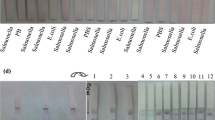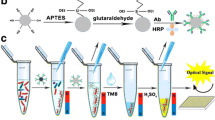Abstract
Salmonella species are ubiquitous human pathogens which pose a dangerous threat to the elderly and children worldwide. In this study, to develop a more efficient assay procedure for the rapid detection of Salmonella Typhimurium, an immunochromatographic strip assay was developed using immunoliposome (anti-Salmonella IgG-tagged) encapsulated with sulforhodamine B (SRB). The detection sensitivity of the developed immunochromatographic assay was compared with a commercial immunochromatographic test strip using colloidal gold nanoparticles. The liposomes were prepared through a reverse-phase evaporation method by using a lipid and phospholipid mixture and SRB, a fluorescence dye, which was encapsulated in the phospholipid bilayer. Furthermore, the outer surface of the SRB-encapsulated liposome was conjugated with antibody (affinity-purified polyclonal goat anti-Salmonella IgG) to form an immunoliposome (size, 223 nm), used as the analytical reagent in the developed immunoassay. For this strip assay, a plastic-backed nitrocellulose strip was immobilized with two antibody zones. The lower zone of the strip referred to Salmonella antigen capture zone (test line), while the other zone served as a positive control (control line). The lower zone was coated with affinity-purified polyclonal goat anti-Salmonella IgG, while the upper zone was coated with rabbit anti-goat IgG. During capillary migration of the wicking solution (diluted liposome and Salmonella culture, each 50 μl), Salmonella was captured with surface-bound immunoliposomes at the antigen capture zone, while the unbound liposomes migrated upward and bound to another zone. The color density of the antigen capture zone was directly proportional to the amount of S. Typhimurium in the test sample. As a result, the detection limit of the immunochromatographic strip assay developed in this study against S. Typhimurium was found to be 102 CFU/ml, which was significantly higher than the detection limit (107 CFU/ml) of the commercial immunochromatographic test strip assay.

The concept of immunochromatographic strip assay






Similar content being viewed by others
References
Chalker RB, Blaser MJ (1988) A review of human salmonellosis: III. Magnitude of Salmonella infection in the United States. Rev Infect Dis 10:111–124
Favrin SJ, Jassim AA, Griffiths MW (2001) Development and optimization of a novel immunomagnetic separation bacteriophage assay for detection of Salmonella enteric Serovar Enteritidis in Broth. Appl Environ Microbiol 67:217–224
Jones BD, Ghori N, Falkow S (1994) Salmonella typhimurium initiates murine infection by penetrating and destroying the specialized epithelial M cells of the Peyer’s patches. J Exp Med 180:15–23
Mansfield L, Forsythe S (1996) Collaborative ring-trial of Dynabeads anti-Salmonella for immunomagnetic separation of stressed Salmonella cells from herbs and spices. Int J Food Microbiol 29:41–47
Blivet D, Salvat G, Humbert F, Colin P (1998) Development of a new culture medium for the rapid detection of Salmonella by indirect conductance measurement. J Appl Microbiol 84:399–403
Jenikova G, Pazlarova J, Demnerova K (2000) Detection of Salmonella in food samples by the combination of immunomagnetic separation and PCR assay. Int Microbiol 3:225–229
Bennet AR, Greenwood D, Tennant C, Banks JG, Betts RP (1998) Rapid and definitive detection of Salmonella in foods by PCR. Lett Appl Microbiol 26:437–441
Gast RK, Holt PS, Nasir MS, Jolley ME, Stone HD (2003) Detection of Salmonella enteritidis in incubated pools of egg contents by fluorescence polarization and lateral flow immunodiffusion. Poult Sci 82(4):687–690
Lee HA, Wyatt GM, Bramham S, Morgan MRA (1990) Enzyme linked immunosorbent assay for Salmonella Typhimurium in food. Appl Environ Microbiol 33:947–954
McEgan R, Fu TJ, Warriner K (2009) Concentration and detection of Salmonella in mung bean sprout spent irrigation water by use of tangential flow filtration coupled with an amperometric flow through enzyme-linked immunosrobent assay. J Food Prot 72(3):591–600
Ho JA, Zeng SC, Tseng WH, Lin YJ, Chen CH (2008) Liposome-based immunostrip for the rapid detection of Salmonella. Anal Bioanal Chem 391:479–485
Muldoon MT, Teaney G, Jingkun LI, Onisk DV, Stave JW (2007) Bacteriophage-based enrichment coupled to immunochromatographic strip-based detection for the determination of Salmonella in meat and poultry. J Food Prot 70(10):2235–2242
Bart JC, Judd LL, Hoffman KE, Wilkins AM, Kusterbeck AW (1997) Application of a portable immunosensor to detect the explosives TNT and RDX in groundwater samples. Environ Sci Technol 31:1505–1511
Shin J, Kim M (2008) Development of liposome immunoassay for Salmonella spp. using immunomagnetic separation and immunoliposome. J Microbiol Biotechnol 18:1689–1694
Ho JA, Drust RA (2000) Development of a flow injection liposome immunoanalysis system for fumonisin B1. Anal Chim Acta 414:61–69
Siebert STA, Reeves SG, Durst RA (1993) Liposome immunomigration field assay device for alachlor determination. Anal Chim Acta 282:297–305
Singh AK, Harrison SH, Schoeniger JS (2000) Gangliosides as receptors for biological toxins: development of sensitive fluoroimmunoassays using ganglioside-bearing liposomes. Anal Chem 72:6019–6024
Park S, Kim M (2008) Physical property and stability of liposome prepared from egg yolk phospholipids at various storage conditions. Korean J Food Sci Ani Resour 28:549–554
Ho JA, Hsu HW (2003) Procedures for preparing Escherichia coli O157:H7 immunoliposome and its application in liposome immunoassay. Anal Chem 75:4330–4334
Szoka F, Olson F, Heath T, Vail W, Mayhew E (1980) Preparation of unilamella liposomes of intermediate size (0.1–0.2 μm) by a combination of reverse phase evaporation and extrusions through polycarbonate membranes. Biochim Biophys Acta 601:559–571
Ahn-Yoon S, DeCory TR, Durst RA (2004) Ganglioside liposome immunoassay for the detection of botulinum toxin. Anal Bioanal Chem 378:68–75
Ho JA, Wu LC, Huang MR, Lin YJ, Baeumner AJ, Durst RA (2007) Application of ganglioside sensitized liposomes in a flow injection immunoanalytical system for the determination of cholera toxin. Anal Chem 79:246–250
Ho JA, Wauchope RD (2002) A strip liposome immunoassay for aflatoxin B1. Anal Chem 74:1493–1496
Kyoko H, Akihisa A, Eiji O, Kohji M, Hideki U, Tetsuhito H, Huifeng R, Hideaki E (2006) Combination of immunomagnetic separation with flow cytometry for detection of Listeria monocytogenes. Analytica Chimica Acta 573–574:158–163
DeCory TR, Drust RA, Zimmerman SJ, Garringer LA, Paluca G, DeCory HH, Montagna RA (2005) Development of an immunomagnetic bead immunoliposome fluorescence assay for rapid detection of Escherichia coli O157:H7 in aqueous samples and comparision of the assay with a standard microbiological method. Appl Environ Microbiol 71:1856–1864
Laitinen-Mika PA, Vuento M (1996) Affinity immunosensor for milk progesterone: identification of critical parameters. Biosens Bioelectron 11:1207–1214
Ho JA, Zeng SC, Tang WH, Lin YJ, Chen CH (2008) Liposome based immunostrip for the rapid detection of Salmonella. Anal Bioanal Chem 391:479–485
Park S, Kim YT, Kim YK (2010) Optical enzyme-linked immunosorbent assay on a strip for detection of Salmonalla Typhimurium. BioChip J 4:110–116
Bautista DA, Elankumaran S, Arking JA, Heckert RA (2002) Evaluation of an immunochromatographic strip assay for the detection of Salmonella spp. from poultry. J Vet Diagn Invest 14:427–430
Masaaki UR, Iwata R, Noda K, Murakami Y, Kuroda A (2009) Detection of living Salmonella cells using bioluminescence. Biotechnol Lett 31:737–741
Nandakumar V (2008) A methodology for rapid detection of Salmonella Typhimurium using label-free electrochemical impedance spectroscopy. Biosens Bioelectron 24:1039–1042
Son JR, Kim G, Kothapalli A, Morgan MT, Ess D (2007) Detection of Salmonella enteritidis using a miniature optical surface plasmon resonance biosensor. J Phys Conf Series 61:1086–1090
Durant JA, Young CR, Nisbet DJ, Stanker LH, Ricke SC (1997) Detection and quantification of poultry probiotic bacteria in mixed culture using monoclonal antibodies in an enzyme-linked immunosorbent assay. Int J Food Microbiol 38:181–189
Perelle S, Dilasser F, Malorny B, Grout J, Hoorfar J, Fach P (2004) Comparison of PCR-ELISA and light cycler realtime PCR assays for detecting Salmonella spp. in milk and meat samples. Mol Cell Probes 18:409–420
Acknowledgment
This research was financed by the Korean Rural Development Agency in 2009.
Author information
Authors and Affiliations
Corresponding author
Electronic supplementary material
Rights and permissions
About this article
Cite this article
Shukla, S., Leem, H. & Kim, M. Development of a liposome-based immunochromatographic strip assay for the detection of Salmonella . Anal Bioanal Chem 401, 2581–2590 (2011). https://doi.org/10.1007/s00216-011-5327-2
Received:
Revised:
Accepted:
Published:
Issue Date:
DOI: https://doi.org/10.1007/s00216-011-5327-2




